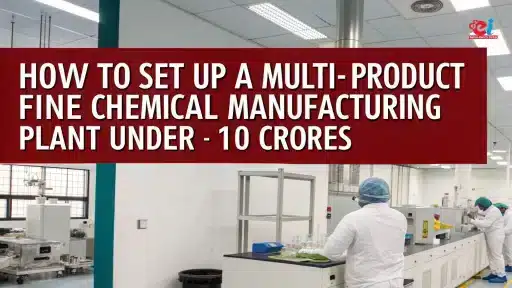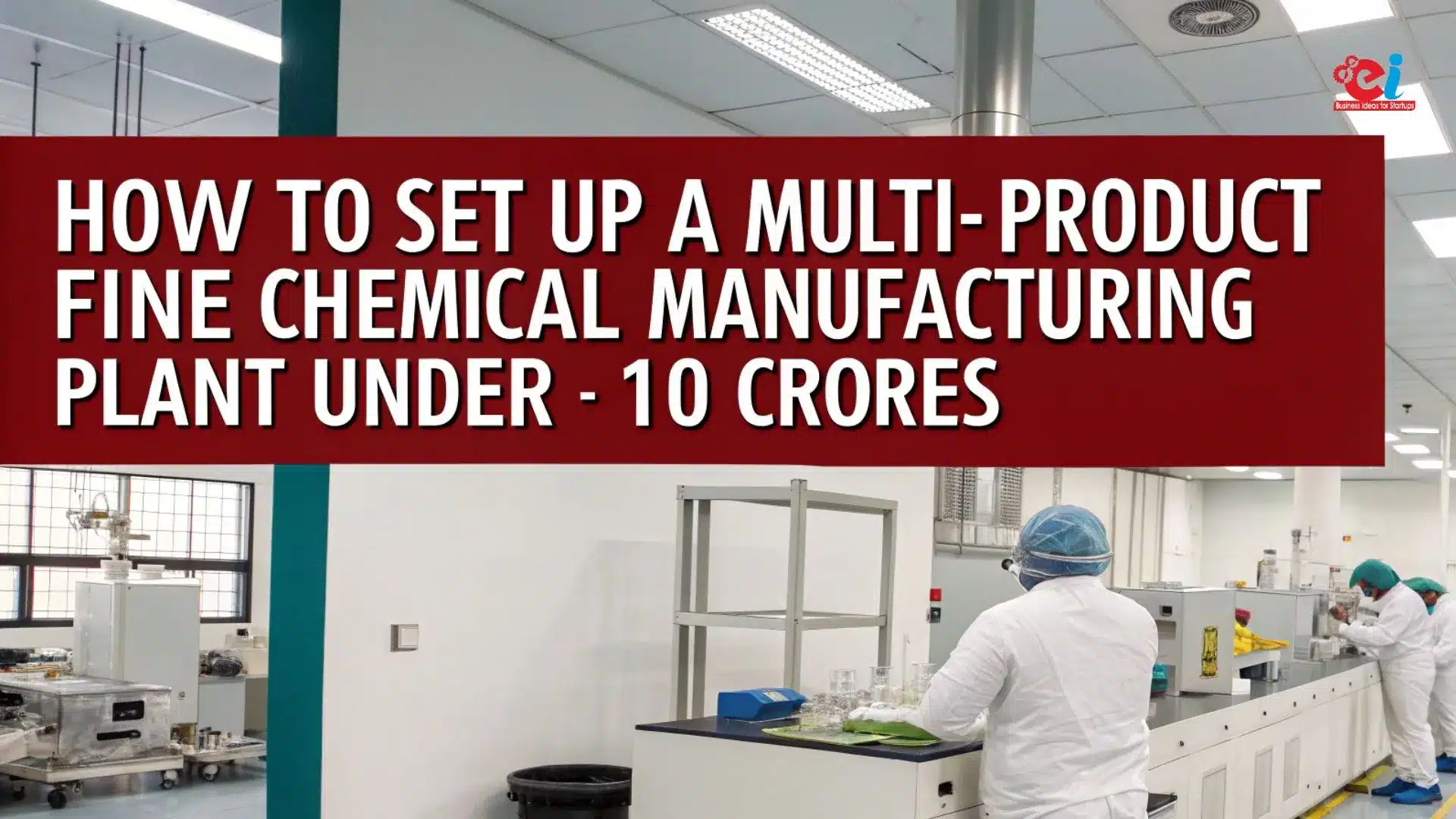Why Fine Chemicals Are the Future of Indian Manufacturing
India’s manufacturing industry is changing. As older sectors reach a tipping point and global markets require more precision, fine chemicals have emerged as one of the most promising verticals for small and medium-scale businesses. Fine chemical manufacturing are also referred to as performance chemicals or specialty intermediates. Moreover, they are high-purity, low-volume compounds used in pharmaceuticals, agrochemicals, paints, food processing, and cosmetics.
Fine chemicals are not bulk commodities because these compounds have strict specifications and consistency standards. Unlike large, scale petrochemical production, starting fine chemical plants is easier than expected due to lower capital investments along with strong margins, especially when designed for multi-product flexibility.
Furthermore, we believe that setting up a multi-product fine chemical unit with an investment under ₹10 crores is feasible in today’s age and provides great opportunities in the longer run. In this case, the venture hopes to secure global exports and B2B partnerships. This guide aims to help you achieve it, starting from concept to compliance, layout to production planning, while ensuring focus on practicality, scalability, and alignment with industry.
What Are Fine Chemicals and Why Is There Demand for Them?
Fine chemicals are separate organic or inorganic molecules manufactured under controlled conditions and in a limited amount. Unlike bulk chemicals, fine chemicals differ from them in Precision and custom work. They are used as building blocks, stabilizers, or additives in sectors that need high consistency or need to follow regulations.
Pharmaceuticals are the largest consumers of fine chemicals, using them as active pharmaceutical ingredients (APIs), intermediates, and other reagents and solvents. Similarly, agrochemical manufacturers depend on fine chemicals for making pesticides, herbicides, and emulsifiers. Food processing industries and dyes, as well as electronic materials, incorporate fine chemicals for stabilization, conductivity, or enhancement.
In addition, fine chemicals are tailored to each application, which makes them less volatile to the market and allows a better price. As a result, that helps build deeper relationships with B2B clients. Therefore, these features make it easier for entrepreneurs who are looking to start a specialized yet easily scalable MSME unit.
Related: How to Launch a Fine Chemical Manufacturing Unit
Business Strategies: Creating a Versatile Fine Chemical System with Multi-Throughput Capabilities
Fine chemicals offer one of the few opportunities for easily switching or diversifying product lines within a single plant and only if it is designed that way. The ideal scenario would be a modular production facility with multifunctional reactors and purification systems.
Smart business strategies suggest to first build a process-based infrastructure instead of product-specific equipment which is costly.Additionally, a variety of chemicals can be produced using similar reaction processes like esterification, halogenation, nitration, sulfonation, and many more with shared reactors, filtration units, and dryers.
Moreover, the previously mentioned targeted sectors—pharmaceuticals, agrochemicals, and cosmetics are ideal starting points to stock. Specifically, from these sectors, choose 5–8 chemical products whose raw materials and reaction schemes are interconnected, that are high in demand inside India or for exports, feasible to be manufactured in batch mode, moderately automated, and involve no extremely hazardous or highly exothermic reactions to reduce CAPEX.
As a result, optimizing your portfolio around these heuristics enables near-continuous production, reduced downtime, optimized inventory, and greater agility in responding to client demands and seasonality.
Fine Chemical Manufacturing Process: Core Setup and Operations
The production of fine chemicals usually follows batch-wise manufacturing, with each batch tailored by temperature, pH, pressure, and catalyst levels. Your core unit should be equipped to handle at least four to five types of reactions supported by universal utilities such as water, steam, chilled water, and nitrogen.
The typical workflow includes:
Raw Material Preparation and Charging
All materials undergo weighing and pre-processing. These are charged into glass-lined reactors (GLRs) or stainless steel reactors (SSRs) based on chemical compatibility.
Reaction Stage
Temperature and pressure are adjusted according to the required chemistry. Agitators, reflux condensers, and dosing pumps help control the reaction profile.
Work-Up and Isolation
Post-reaction, side products are separated. The chemical is then neutralized, quenched, or solvent-extracted, or balanced through pH.
Purification and Drying
Defined steps include crystallization, filtration, and distillation which also fall under recovery of solvents. Drying process employs tray and vacuum dryers, even centrifuges.
Quality Control and Packing
Testing and packing of lab samples are done in HDPE drums or fiber containers ensuring batch traceability and documentation that meet industry standards. All samples undergo tests on purity, moisture, color, and melting point which are assessed using titration, GC, HPLC, and UV-spectroscopy.
Patients trusting a clinic with their health expect thorough competencies and so do customers in industries that require strict adherence to compliance. For operational competence, the crew must be qualified in recipe handling, parameter change, and documentation compliance on a per-batch basis.
Related: A Guide for Chemical Business Startups
Infrastructure and Equipment Strategy
Your plant should employ shared infrastructure to comply with the strict budget of ₹10 crore without compromising quality. Here’s how to balance flexibility with cost.
- Land and Building: A separate zoned unit for processing, quality control, storage, and utilities within the 10,000 to 15,000 sq. ft. range ensuring adequate height clearance and ventilation for reactor exhausts.
- Reactors: 2 to 3 glass lined reactors and 1 to 2 SSRs jacketed for temperature control with heating zones between the jacket and glass.
- Filtration & Drying: Based on product characteristics, nutsche filters, centrifuges, or tray and vacuum dryers.
- Utilities: Cooling tower, vacuum pumps, boiler, solvent tanks, nitrogen generation system, and scrubbers.
- Quality Lab: HPLC, GC, melting point apparatus, spectrophotometer, and general chemical analysis tools.
- Safety Systems: Flameproof motors and PPE, firefighting systems, grounding systems, MSDS compliance.
Solvent and raw material handling should allow for the fastest possible changeover between production batches and eliminate as much waste as possible.
Regulatory and Compliance Roadmap
Due to the fine chemicals strict quality and safety regulations, they are used in sensitive pharmaceutical and food industries. Every compliance obstacle is manageable for an MSME setup of ₹10 crore with strategic planning.
- Clearance from the pollution control board (PCBs) is needed for air, water, and hazardous waste management. ETP and scrubbers need to be installed.
- Under the factories act, each factory needs a license and building plan approval.
- This is a specific registration for businesses using flammable solvents or other controlled raw materials and regulated equipment.
- To access government programs and secure loans, this registration is mandatory.
- For safety, environment, and quality ISOs 9001, 14001, and 45001 are recommended.
- For exportation or for materials of pharmaceutical grade, REACH or GMP compliance is needed.
- It is essential to maintain legal safety for each product manufactured by having batch records, coa’s, and safety data sheets.
Sourcing and Supply Chain Essentials
Sourcing raw materials is very important for success in fine chemical manufacturing. Your facility should be able to procure high purified starting materials such as acids, aldehydes, solvents, and reagents from reliable vendors. Furthermore, your facility should uphold rigorous inventory policies in order to prevent any unnecessary downtime.
Due to fine chemical products being specialized, lead times tend to be longer in comparison to commodity chemicals. Securing supply contracts with brokers and distributors, and utilizing IndiaMART, ChemSpider, and MolBase can help improve stability.
Products should be sold both in bulk (to formulation plants) or as small-batch packs (for laboratories and OEMs). Building partnerships with chemical resellers to guarantee ongoing purchasing orders alongside API manufacturers and agrochemical blenders will improve order stability.
Logistical operations must follow hazmat standards, and paperwork such as invoicing and compliance with GST, and batch tracking should be done carefully.
The Role of NPCS in Setting Up a Fine Chemical Plant
Navigating this industry is complex—but entrepreneurs don’t have to do it alone. Niir Project Consultancy Services (NPCS) provides in-depth support through its Techno-Economic Feasibility Reports, customized for MSMEs in the chemical sector.
NPCS reports cover:
- Detailed manufacturing processes, equipment list, and plant layout plans
- Raw material sources, quality standards, and capacity optimization
- End-user demand analysis across sectors like pharma, agro, and specialty formulations
- Regulatory compliance, safety protocols, and pollution control best practices
- Financials, market positioning, and export planning
Whether you’re a first-generation entrepreneur or a chemical trader looking to expand, NPCS gives you the clarity to move from idea to implementation confidently.
For more information check our Project Reports
Conclusion: Building an MSME That’s Future-Ready
Fine chemical manufacturing is no longer a domain reserved for large players or global MNCs. With careful design, a modular production mindset, and the right partners, Indian MSMEs can tap into high-margin, innovation-driven markets that demand consistency, flexibility, and speed.
With a budget under ₹10 crores, entrepreneurs can establish a multi-product facility capable of serving pharma intermediates, agrochemical raw materials, cosmetic bases, and even export-oriented chemicals. It’s not just an investment in machinery—it’s a commitment to quality, niche expertise, and long-term industrial value.
In the era of precision manufacturing and global supply realignment, this is your opportunity to build a small-scale unit with large-scale impact.







